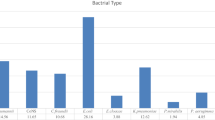Abstract
Objective
To measure the frequency of antimicrobial resistance in pediatric blood culture isolates of Escherichia coli and Klebsiella spp. with focus on carbapenem resistance.
Methods
Over a period of three years, pediatric blood culture isolates were tested for antimicrobial susceptibility, including molecular investigations for carbapenem resistance.
Results
Amikacin, carbapenems, colistin and tigecycline had an antimicrobial efficacy of >70% (n=140). 7 of the 15 randomly selected isolates were positive for carbapenemase gene; among them, five were New Delhi Metallo β-lactamase (NDM).
Conclusion
There was a high prevalence of Klebsiella spp. in pediatric bacteremia and dissemination of NDMmediated carbapenem resistance in pediatric wards.
Similar content being viewed by others
References
World Health Organisation. Global Health Observatory Data: Causes of Child Mortality, 2015 (Updated 2016). Available from: http://www.who.int/gho/child_health/mortality/causes/en/. Accessed February 11, 2017.
Logan LK. Carbapenem-resistant Enterobacteriaceae: an emerging problem in children. Clin Infect Dis. 2012;55:852–9.
Pannaraj PS, Bard JD, Cerini C, Weissman SJ. Pediatric carbapenem-resistant Enterobacteriaceae in Los Angeles, California, a high-prevalence region in the United States. Pediatr Infect Dis J. 2015;34:11–6.
Morkel G, Bekker A, Marais BJ, Kirsten G, van Wyk J, Dramowski A. Bloodstream infections and antimicrobial resistance patterns in a South African neonatal intensive care unit. Pediatr Int Child Health. 2014;34:108–14.
Hamer DH, Darmstadt GL, Carlin JB, Zaidi AK, Yeboah-Antwi K, Saha SK, et al. Etiology of bacteremia in young infants in six countries. Pediatr Infect Dis J. 2015;34: e1–8.
Winn CW, Allen SD, Janda WM, Koneman EW, Procop GW, Schreckenberger PC, et al. (eds): Koneman’s Color Atlas and Textbook of Diagnostic Microbiology, 6th ed. New York: Lippincott. 2006.
Hall KK, Lyman JA. Updated review of blood culture contamination. Clin Microbiol Rev. 2006;19:788–802.
CLSI. Performance Standards for Antimicrobial Susceptibility Testing; Twenty-second Informational Supplement. Clinical and Laboratory Standards Institute, USA. 2015;CLSI document M100-S22.
Halaby T, Al Naiemi N, Kluytmans J, van der Palen J, Vandenbroucke-Grauls CM. Emergence of colistin resistance in Enterobacteriaceae after the introduction of selective digestive tract decontamination in an intensive care unit. Antimicrob Agents Chemother. 2013;57:3224–9.
Food and Drug Administration. Tygacil (Tigecycline) for injection (Updated December 2008). Available from: http://www.accessdata.fda.gov/drugsatfda_docs/label/2009/021821s016lbl.pdf. Accessed February 11, 2017.
Monteiro J, Widen RH, Pignatari AC, Kubasek C, Silbert S. Rapid detection of carbapenemase genes by multiplex real-time PCR. J Antimicrob Chemother. 2012;67:906–9.
Chea N, Bulens SN, Kongphet-Tran T, Lynfield R, Shaw KM, Vagnone PS, et al. Improved phenotype-based definition for identifying carbapenemase producers among Carbapenem-Resistant Enterobacteriaceae. Emerg Infect Dis. 2015;21:1611–6.
Sekar R, Mythreyee M, Srivani S, Amudhan M. Prevalence of antimicrobial resistance in Escherichia coli and Klebsiella spp. in rural South India. J Glob Antimicrob Resist. 2016;5:80–5.
Viau R, Frank KM, Jacobs MR, Wilson B, Kaye K, Donskey CJ, et al. Intestinal carriage of carbapenemaseproducing organisms: Current status of surveillance methods. Clin Microbiol Rev. 2016;29:1–27.
Author information
Authors and Affiliations
Corresponding author
Rights and permissions
About this article
Cite this article
Sekar, R., Mythreyee, M., Srivani, S. et al. Carbapenem-resistant Enterobacteriaceae in pediatric bloodstream infections in rural Southern India. Indian Pediatr 54, 1021–1024 (2017). https://doi.org/10.1007/s13312-017-1204-1
Received:
Revised:
Accepted:
Published:
Issue Date:
DOI: https://doi.org/10.1007/s13312-017-1204-1




